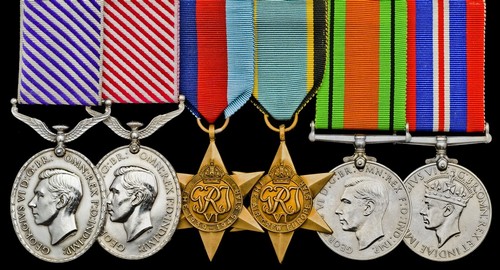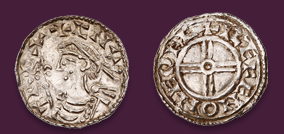
Auction: 14001 - Orders, Decorations, Campaign Medals and Militaria
Lot: 79
An Extremely Rare Second War D.F.M., A.F.M. Group of Six to Whitley and Wellington Wireless Operator, Flight Sergeant A. Sayner, Royal Air Force Volunteer Reserve, Who Flew in At Least 27 Operational Sorties, Including Having to Bale Out at 9,500 Feet Returning From Bremen, 11.2.1941. He Was Killed in Action On A Raid to Cologne, 15/16.10.1942
a) Distinguished Flying Medal, G.VI.R. (939971. Sgt. A. Sayner. R.A.F.)
b) Air Force Medal, G.VI.R. (939971. F/Sgt. A. Sayner. R.A.F.)
c) 1939-1945 Star
d) Air Crew Europe Star
e) Defence and War Medals, generally very fine or better, with photographic image of recipient, photocopies of two poems written by Sayner in the year of his death, and other research (6)
D.F.M. London Gazette 7.3.1941 939971 Sergeant Arthur Saynor [sic], 58 Squadron
The Recommendation states: 'As Wireless Operator, this airman has completed 20 operational flights including four bombing attacks on Berlin. It has been largely due to his skill that aircraft returning from long distance targets have landed safely at their base. This young Sergeant has a very fine operational record and has set a splendid example.'
A.F.M. London Gazette 1.1.1943 939971 Flight Sergeant Arthur Sayner, No. 10 O.T.U.
The Recommendation (covering the period 1.2.1942-31.7.1942) states: 'For the past twelve months this airman has been employed as a screened wireless operator/air gunner and has completed 743 hours of flying of which 210 hours have been at night. Although this flying has been of a rather dull and routine nature, by his enthusiasm and untiring energy Flight Sergeant Sayner has set an outstanding example to all.'
939971 Flight Sergeant Arthur Sayner, D.F.M., A.F.M., born Hessle, Yorkshire; educated at the Malet Lambert High School, Hull, and was apprenticed as a Poster Artist to Harvey's Advertising Agency; joined Royal Air Force Volunteer Reserve, August 1939; posted as a Wireless Operator to 58 Squadron (Whitley's), Linton-on-Ouse; he flew in at least 24 operational sorties with the squadron, between September 1940 - May 1941; these sorties included to Berlin (4); Ostend Harbour, 15.9.1940, 'Attack made from 3,000 feet at 00.05 hours. Bombs seen to burst across docks. Second stick of bombs across No. 2 Basin. A large transport vessel believed hit was seen to catch fire. Returned to base.' (Squadron Operations Record Book refers); Zeebrugge; Gelsenkirchen; Levna; Stettin; the Skoda Works at Pilsen; Lorient (2); Antwerp; Mannheim; Bremen (2), including 11/12.2.1941, 'On return owing to shortage of petrol crew forced to bale out at 9,500 feet and aircraft crashed near Wishaw, Lanarkshire. All crew successful descents by parachute and were uninjured' (Ibid); Brest (3); Wilhelmshaven; Dusseldorf (2); Kiel; and Rotterdam; he was subsequently posted to No. 10 O.T.U., (Whitleys) Abingdon, before returning to operational flying as part of Path Finder Force with 156 Squadron (Wellingtons), Warboys; he flew in at least 3 operational sorties with the squadron between September-October 1942, including to Bremen; Frankfurt and Dusseldorf; Sayner's final sortie was in Wellington III BK339 GT- piloted by Squadron Leader J. Hobbs to Cologne, 15/16.10.1942; the aircraft failed to return from the mission, and the crew of five, including Sayner, are commemorated on the Runnymede Memorial.
The following poem was written by Sayner before his fatal 'moon light' raid:
'It is a lovely moonlit night. Just six words; but do not read them as if they had been announced by a radio commentator.
I regret that it is not possible to set down in black ink upon a white sheet how my mind intoned that phrase.
The lunar orb, half apparent as a backcloth to the silhouetted trees on the horizon, rises slowly diffuses its light over the lower eastern sky; changing in colour as it ascends and leaves the screen of the earth mists, from orange to silver.
Now it is hidden behind a blanket of cirrus clouds which hang from the sky like a half drawn blind.
It is a lovely moonlit night. Soon the moon will be at its height casting long shadows across the roads, rivers and fields of England; of Europe.
It is a harvest moon; a lover's moon; a bomber's moon.
Friendly light that sends the dark spectre of night scurrying into unlit corners.
Terrible light that turns night into half day, and becomes a fighter's moon.
"Thirty of our aircraft failed to return from all these operations."
Harsh words that read as they are written.
It was a lovely moonlit night.'
1 of 17 D.F.M., A.F.M. combinations awarded, of which only 4 were awarded during the Second World War.
Subject to 20% VAT on Buyer’s Premium. For more information please view Terms and Conditions for Buyers.
Sold for
£7,500




